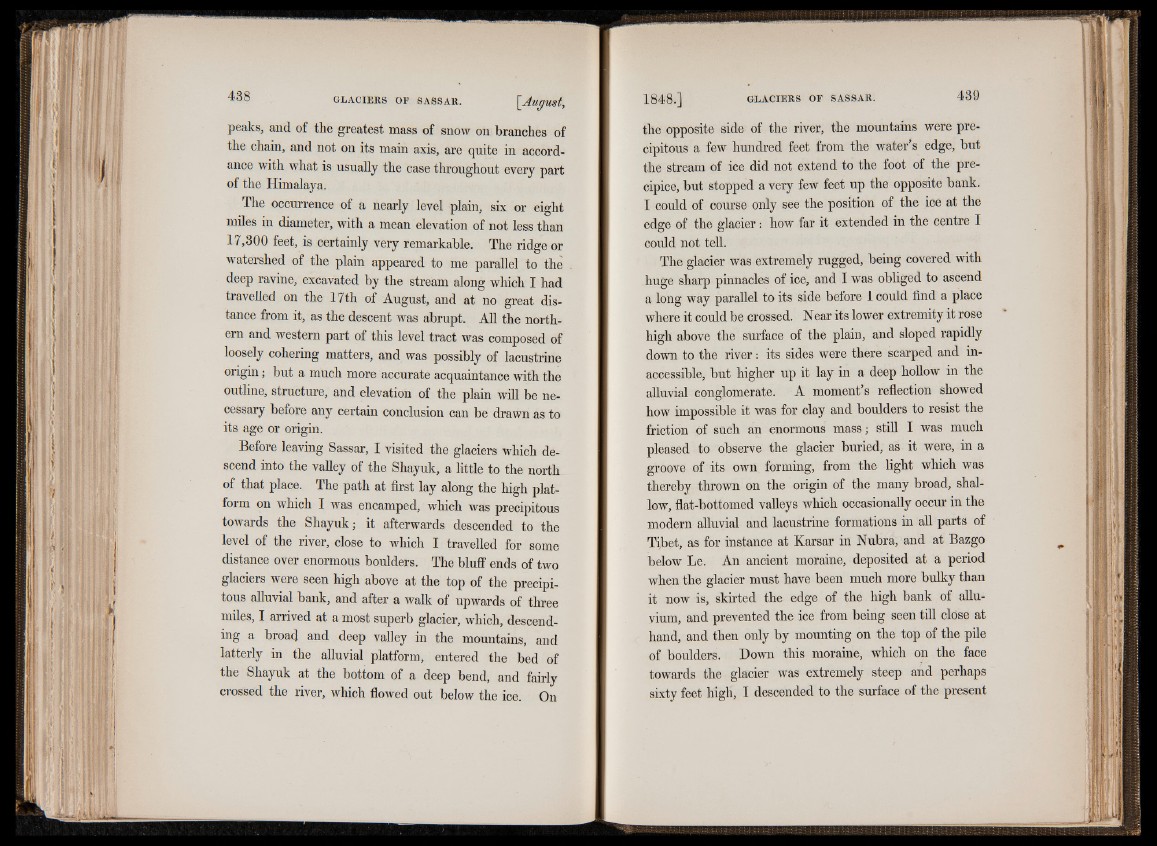
peaks, and of the greatest mass of snow on branches of
the chain, and not on its main axis, are quite in accordance
with what is usually the case throughout every part
of the Himalaya.
The occurrence of a nearly level plain, six or eight
miles in diameter, with a mean elevation of not less than
17,300 feet, is certainly very remarkable. The ridge or
watershed of the plain appeared to me parallel to the
deep ravine, excavated by the stream along which I had
travelled on the 17th of August, and at no great distance
from it, as the descent was abrupt. All the northern
and western part of this level tract was composed of
loosely cohering matters, and was possibly of lacustrine
origin; but a much more accurate acquaintance with the
outline, structure, and elevation of the plain will be necessary
before any certain conclusion can be drawn as to
its age or origin.
Before leaving Sassar, I visited the glaciers which descend
into the valley of the Shayuk, a little to the north
of that place. The path at first lay along the high platform
on which I was encamped, which was precipitous
towards the Shayuk; it afterwards descended to the
level of the river, close to which I travelled for some
distance over enormous boulders. The bluff ends of two
glaciers were seen high above at the top of the precipitous
alluvial bank, and after a walk of upwards of three
miles, I arrived at a most superb glacier, which, descending
a broad and deep valley in the mountains, and
latterly in the alluvial platform, entered the bed of
the Shayuk at the bottom of a deep bend, and fairly
crossed the river, which flowed out below the ice. On
the opposite side of the river, the mountains were precipitous
a few hundred feet from the water’s edge, but
the stream of ice did not extend to the foot of the precipice,
but stopped a very few feet up the opposite bank.
I could of course only see the position of the ice at the
edge of the glacier: how far it extended in the centre I
could not tell.
The glacier was extremely rugged, being covered with
huge sharp pinnacles of ice, and I was obliged to ascend
a long way parallel to its side before I could find a place
where it could be crossed. Near its lower extremity it rose
high above the surface of the plain, and sloped rapidly
down to the river: its sides were there scarped and inaccessible,
but higher up it lay in a deep hollow in the
alluvial conglomerate. A moment’s reflection showed
how impossible it was for clay and boulders to resist the
friction of such an enormous mass; still I was much
pleased to observe the glacier buried, as it were, in a
groove of its own forming, from the light which was
thereby thrown on the origin of the many broad, shallow,
flat-bottomed valleys which occasionally occur in the
modern alluvial and lacustrine formations in all parts of
Tibet, as for instance at Karsar in Nubra, and at Bazgo
below Le. An ancient moraine, deposited at a period
when the glacier must have been much more bulky than
it now is, skirted the edge of the high bank of alluvium,
and prevented the ice from being seen till close at
hand, and then only by mounting on the top of the pile
of boulders. Down this moraine, which on the face
towards the glacier was extremely steep and perhaps
sixty feet high, I descended to the surface of the present